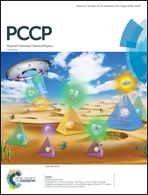How does graphene grow on complex 3D morphologies?†
Abstract
The growth of two-dimensional materials into three-dimensional geometries holds the promise for high performance hybrid materials and novel architectures. The synthesis of such structures, however, proceeds in fundamentally different flow regimes compared to conventional CVD where pressure differences and wall collisions are neglected. We here demonstrate the remarkable stability of graphene growth under varying fluid dynamic flow regimes. We investigate the growth process across different flow conditions using confined growth in refractory pores. Analysis of the growth rate reveals a transport-limited process which allows experimental determination of the gas diffusion coefficient. The diffusion coefficient was found to be constant for large pore dimension but scales with pore dimension as the pore size decreases below the mean free path providing clear evidence for previously predicted Knudsen molecular-flow conditions for atomic confinement. Surprisingly, changes to the flow conditions by two orders of magnitude do not cause qualitative changes of the graphene growth process. This unique behavior was attributed to rarefied flow conditions by scaling analysis and an analytical relation between growth rate and constriction could be extracted that proves accurate throughout the investigated conditions. Our results demonstrate a fundamentally different growth process compared to traditional CVD processes that is akin to atomic layer deposition and highlight the feasibility of high-quality 2D-material growth on 3D morphologies with ultra-high aspect ratios.



 Please wait while we load your content...
Please wait while we load your content...